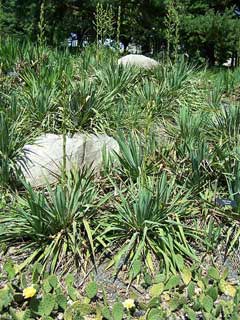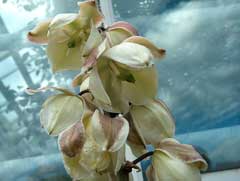 |
|
commons.wikimedia.org/wiki/User:SEWilco |
 |
| commons.wikimedia.org/wiki/User:Annelis |
Translate this page:
Summary
Bloom Color: White. Main Bloom Time: Late summer, Mid summer. Form: Upright or erect.
Physical Characteristics

 Yucca_glauca is an evergreen Shrub growing to 1.5 m (5ft) by 0.5 m (1ft 8in) at a slow rate.
Yucca_glauca is an evergreen Shrub growing to 1.5 m (5ft) by 0.5 m (1ft 8in) at a slow rate.
See above for USDA hardiness. It is hardy to UK zone 4. It is in leaf all year, in flower from July to August. The species is hermaphrodite (has both male and female organs) and is pollinated by Hand.
Suitable for: light (sandy), medium (loamy) and heavy (clay) soils, prefers well-drained soil and can grow in nutritionally poor soil. Suitable pH: mildly acid, neutral and basic (mildly alkaline) soils. It can grow in semi-shade (light woodland) or no shade. It prefers dry or moist soil and can tolerate drought. The plant can tolerates strong winds but not maritime exposure.
UK Hardiness Map
US Hardiness Map
Synonyms
Y. angustifolia.
Plant Habitats
Edible Uses
Fruit - raw or cooked[2, 46, 61, 161, 257]. Dry, with a bitter skin[85]. The fruit can be baked and either eaten immediately or formed into cakes and dried for later use[257]. The raw fruit can be dried for winter use[1, 257]. The immature fruits are peeled, boiled and served with seasonings[183]. The soaked, cooked fruit can be made into a syrup and used like hot chocolate[257]. The fruit is up to 8cm long and 12mm wide[2]. Flowers and flower buds - raw or cooked[61, 85]. Delicious raw, they can also be dried, crushed and used as a flavouring[164]. A delicious addition to the salad bowl, or used as a potherb[183]. Flowering stem - raw or cooked[62, 85, 161, 257]. It can be cooked and used like asparagus[164]. The white inner portion of the stem is eaten[183]. Seedpods - cooked. They can be boiled or roasted and used as a vegetable[257]. The plant crowns have been roasted and eaten in times of food shortage[257].
References More on Edible Uses
Medicinal Uses
Plants For A Future can not take any responsibility for any adverse effects from the use of plants. Always seek advice from a professional before using a plant medicinally.
A soap made from the crushed roots is said to be an effective treatment for dandruff and skin irritations[213, 222]. A cold infusion of the root has been used to expedite the delivery of a child or the placenta[257]. The root is poulticed and applied to inflammations, wounds, bleeding cuts, sprains etc[222, 257]. The rotten root can be crushed and boiled to make suds. Drinking these suds is said to induce the menopause in women, thereby rendering then infertile[257].
References More on Medicinal Uses
The Bookshop: Edible Plant Books
Our Latest books on Perennial Plants For Food Forests and Permaculture Gardens in paperback or digital formats.

Edible Tropical Plants
Food Forest Plants for Hotter Conditions: 250+ Plants For Tropical Food Forests & Permaculture Gardens.
More

Edible Temperate Plants
Plants for Your Food Forest: 500 Plants for Temperate Food Forests & Permaculture Gardens.
More

More Books
PFAF have eight books available in paperback and digital formats. Browse the shop for more information.
Shop Now
Other Uses
Both the leaves, and a fibre obtained from the leaves, can be used for making cloth, ropes and mats[21, 57, 61, 82, 85, 169, 257]. The leaves can be split and used to make baskets[257]. The leaves are used as paint brushes and brooms[46, 85, 92]. The leaves can be split and used as a temporary tying material[257]. The sharp points of the leaves have been used as needles[257]. The roots are rich in saponins and can be used as a soap substitute[82, 85, 95]. The soap obtained from the root makes a good hair shampoo[95], it is said to be effective against dandruff and also to act as a tonic to stop the hair falling out[213, 257]. The shampoo also rids the body of lice and other parasites[257].
Special Uses
References More on Other Uses
Cultivation details
Landscape Uses:Border, Erosion control, Massing, Rock garden, Seashore, Specimen. Thrives in most soils but prefers a sandy loam and full exposure to the south[11]. Dislikes chalky or peaty soils[111]. Can succeed in light shade[K]. Plants are hardier when grown on poor sandy soils[200]. Prefers a hot dry position and a poor soil[166]. Established plants are very drought tolerant[200]. Hardy to at least -30°c according to one report[164], whilst another one says that it is hardy to about -15°c[200]. A very ornamental plant[1], it rarely flowers unless in a dry sandy soil[42]. The scent of the flowers is most pronounced at night[245]. In the plants native environment, its flowers can only be pollinated by a certain species of moth. This moth cannot live in Britain and, if fruit and seed is required, hand pollination is necessary. This can be quite easily and successfully done using something like a small paint brush[1]. Individual crowns are monocarpic, dying after flowering[233]. However, the crown will usually produce a number of sideshoots before it dies and these will grow on to flower in later years[233]. Plants in this genus are notably resistant to honey fungus[200]. Members of this genus seem to be immune to the predations of rabbits[233]. Special Features:Attractive foliage, North American native.
References Carbon Farming Information and Carbon Sequestration Information
Temperature Converter
Type a value in the Celsius field to convert the value to Fahrenheit:
Fahrenheit:
The PFAF Bookshop
Plants For A Future have a number of books available in paperback and digital form. Book titles include Edible Plants, Edible Perennials, Edible Trees,Edible Shrubs, Woodland Gardening, and Temperate Food Forest Plants. Our new book is Food Forest Plants For Hotter Conditions (Tropical and Sub-Tropical).
Shop Now
Plant Propagation
Seed - sow spring in a greenhouse. Pre-soaking the seed for 24 hours in warm water may reduce the germination time. It usually germinates within 1 - 12 months if kept at a temperature of 20°c. Prick out the seedlings into individual pots when they are large enough to handle and grow them on in the greenhouse or cold frame for at least their first two winters. Plant them out into their permanent positions in early summer and consider giving them some winter protection for at least their first winter outdoors - a simple pane of glass is usually sufficient[K]. Seed is not produced in Britain unless the flowers are hand pollinated. Root cuttings in late winter or early spring. Lift in April/May and remove small buds from base of stem and rhizomes. Dip in dry wood ashes to stop any bleeding and plant in a sandy soil in pots in a greenhouse until established[78]. Division of suckers in late spring. Larger divisions can be planted out direct into their permanent positions. We have found that it is best to pot up smaller divisions and grow them on in light shade in a greenhouse or cold frame until they are growing away well. Plant them out in the following spring.
Other Names
If available other names are mentioned here
Native Range
NORTHERN AMERICA: Canada (Alberta (south)), United States (Iowa (west), Kansas, Missouri, Nebraska, North Dakota, South Dakota, Oklahoma, Colorado, Montana, Wyoming, New Mexico, Texas (north))
Weed Potential
Right plant wrong place. We are currently updating this section.
Please note that a plant may be invasive in one area but may not in your area so it’s worth checking.
Conservation Status
IUCN Red List of Threatened Plants Status :

Growth: S = slow M = medium F = fast. Soil: L = light (sandy) M = medium H = heavy (clay). pH: A = acid N = neutral B = basic (alkaline). Shade: F = full shade S = semi-shade N = no shade. Moisture: D = dry M = Moist We = wet Wa = water.
Expert comment
Author
Nutt.
Botanical References
1160200
Links / References
For a list of references used on this page please go here
Readers comment
© 2010, Plants For A Future. Plants For A Future is a charitable company limited by guarantee, registered in England and Wales. Charity No. 1057719, Company No. 3204567.